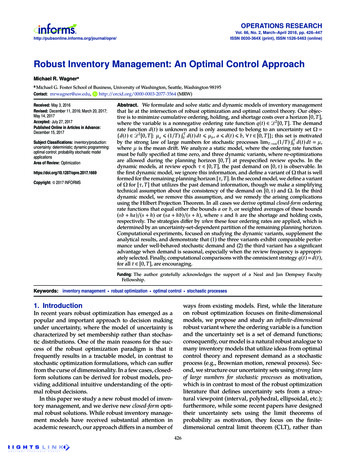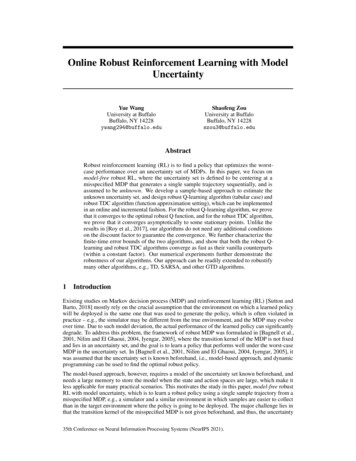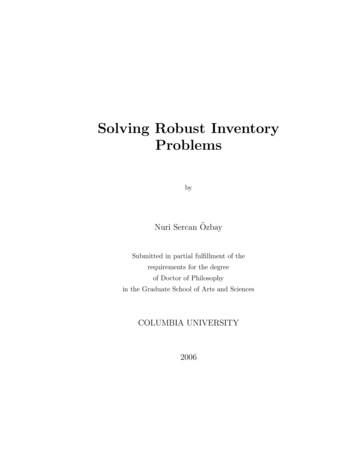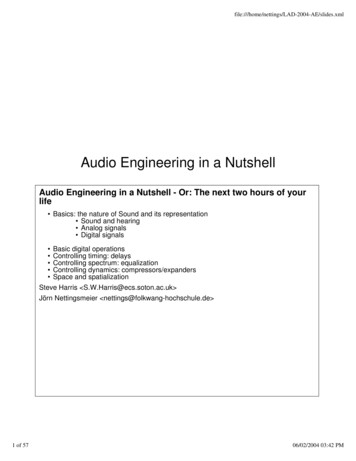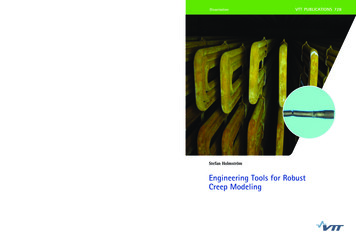
Transcription
VTT CREATES BUSINESS FROM TECHNOLOGY Technology and market foresight Strategic research Product and service development IPR and licensing Assessments, testing, inspection, certification Technology and innovation management Technology partnershipVTT PUBLICATIONS 728 VTT PUBLICATIONS 728 ENGINEERING TOOLS FOR ROBUST CREEP MODELINGCreep models are needed for design and life management of structural componentsoperating at high temperatures. The determination of creep properties require longterm testing often limiting the amount of data. It is of considerable interest to beable to reliably predict and extrapolate long term creep behavior from relativelysmall sets of creep data. In this thesis tools have been developed to improve thereliability of creep rupture, creep strain and weld strength predictions. Much of theresulting improvements and benefits are related to the reduced requirements forsupporting creep data. The simplicity and robustness of the new tools also makethem easy to implement in analytical and numerical solutions. Creep models forselected high temperature steels and OFP copper are presented.DissertationStefan HolmströmEngineering Tools for RobustCreep ModelingISBN 978-951-38-7378-3 (soft back ed.)ISSN 1235-0621 (soft back ed.)ISBN 978-951-38-7379-0 (URL: http://www.vtt.fi/publications/index.jsp)ISSN 1455-0849 (URL: http://www.vtt.fi/publications/index.jsp)
VTT PUBLICATIONS 728Engineering Tools forRobust Creep ModelingStefan HolmströmDissertation for the degree of Doctor of Science in Technology to be presented with due permission of the Faculty of Engineering and Architecture,The Aalto University School of Science and Technology, for public examination and debate in K216 at Aalto University (Otakaari 4, Espoo, Finland)on the 5th of February, 2010, at 12 noon.
ISBN 978-951-38-7378-3 (soft back ed.)ISSN 1235-0621 (soft back ed.)ISBN 978-951-38-7379-0 (URL: http://www.vtt.fi/publications/index.jsp)ISSN 1455-0849 (URL: http://www.vtt.fi/publications/index.jsp)Copyright VTT 2010JULKAISIJA – UTGIVARE – PUBLISHERVTT, Vuorimiehentie 5, PL 1000, 02044 VTTpuh. vaihde 020 722 111, faksi 020 722 4374VTT, Bergsmansvägen 5, PB 1000, 02044 VTTtel. växel 020 722 111, fax 020 722 4374VTT Technical Research Centre of Finland, Vuorimiehentie 5, P.O. Box 1000, FI-02044 VTT, Finlandphone internat. 358 20 722 111, fax 358 20 722 4374Technical editing Mirjami PullinenEdita Prima Oy, Helsinki 2010
Stefan Holmström. Engineering Tools for Robust Creep Modeling [Virumismallinnuksen uudet menetelmät]. Espoo 2010. VTT Publications 728. 94 p. 53 p.Keywordscreep, strain, damage, modeling, steel, OFP copperAbstractHigh temperature creep is often dealt with simplified models to assess and predict the future behavior of materials and components. Also, for most applicationsthe creep properties of interest require costly long-term testing that limits theavailable data to support design and life assessment. Such test data sets are evensmaller for welded joints that are often the weakest links of structures. It is ofconsiderable interest to be able to reliably predict and extrapolate long termcreep behavior from relatively small sets of supporting creep data.For creep strain, the current tools for model verification and quality assuranceare very limited. The ECCC PATs can be adapted to some degree but the uncertainty and applicability of many models are still questionable outside the rangeof data. In this thesis tools for improving the model robustness have been developed. The toolkit includes creep rupture, weld strength and creep strain modeling improvements for uniaxial prediction. The applicability is shown on data setconsisting of a selection of common high temperature steels and the oxygen-freephosphorous doped (OFP) copper. The steels assessed are 10CrMo9-10 (P22),7CrWVMoNb9-6 (P23), 7CrMoVTiB10-10 (P24), 14MoV6-3 (0.5CMV),X20CrMoV11-1 (X20), X10CrMoVNb9-1 (P91) and X11CrMoWVNb9-1-1(E911).The work described in this thesis has provided simple yet well performingtools to predict creep strain and life for material evaluation, component designand life assessment purposes. The uncertainty related to selecting the type ofmaterial model or determining weld strength factors has been reduced by theselection procedures and by linking the weld behavior to the base material master equation. Much of the resulting improvements and benefits are related to thereduced requirements for supporting creep data. The simplicity and robustness ofthe new tools also makes them easy to implement for both analytical and numerical solutions.3
Stefan Holmström. Engineering Tools for Robust Creep Modeling [Virumismallinnuksen uudet menetelmät]. Espoo 2010. VTT Publications 728. 94 s. liitt. 53 s.Keywordscreep, strain, damage, modeling, steel, OFP copperTiivistelmäRakenteiden suunnitteluun ja elinikäennusteisiin käytetyt kuumalujien terästenlujuusarvot ja hitsien lujuuskertoimet pohjautuvat virumiskoetuloksiin, joita onvarsinkin pitkäaikaisina käytettävissä usein vain niukasti. Sen vuoksi on erityisen tärkeää, että koetuloksiin sovitetut materiaalimallit ovat taloudellisia, tarkkoja ja luotettavia erityisesti ekstrapoloitaessa pidemmille käyttöajoille.Tässä väitöstyössä on kehitetty uusia malleja työkaluiksi virumismurtolujuuden, hitsien lujuuskertoimien ja virumisvenymän luotettavaan määrittämiseensekä virumiseliniän ennustamiseen erityisesti tapauksissa, joissa mallinnuksentueksi on käytettävissä niukasti virumiskoetuloksia. Uusien mallien suorituskykyä on testattu eurooppalaisessa vertailututkimuksessa, jossa ne ennustivat yksin-kertaisesta muodostaan huolimatta venymiä tarkemmin kuin aiemmat jahuomattavasti monimutkaisemmat virumismallit. Uusia malleja on työssä sovellettu OFP-kuparille ja ferriittisille teräksille 10CrMo9-10 (P22), 7CrWVMoNb96 (P23), 7CrMoVTiB10-10 (P24), 14MoV6-3 (0.5CMV), X20CrMoV11-1(X20), X10CrMoVNb9-1 (P91) ja X11CrMoWVNb9-1-1 (E911). Materiaalimalleja on myös sovitettu numeerisen suunnittelun työkaluihin (COMSOL jaABAQUS) ja verifioitu pitkään käytössä olleen hitsatun putkiyhteen elinikätarkastelulla.Väitöstyön tuloksena kehitettyjä malleja ja menetelmiä voivat soveltaa korkean lämpötilan rakenteiden suunnittelijat ja eliniän hallinnan asiantuntijat helpottamaan ja tarkentamaan virumiskäyttäytymisen ennustamista. Työn keskeinenanti on kehitettyjen menetelmien tarjoama vähentynyt materiaalidatan tarve jamallien yksinkertainen rakenne, joka helpottaa niiden hyödyntämistä sekä analyyttisissä että numeerisissa ratkaisuissa.4
PrefaceThis work has been carried out at VTT, financially supported by the Academy ofFinland grant 117700 with prof. Kim Wallin acting as instructor. It has beensupervised by prof. Hannu Hänninen, head of laboratory of Engineering Materials at Helsinki University of Technology (HUT). Prof. Hänninen is greatly acknowledged for his valuable input in the finalization stage of the thesis and forarranging a place at HUT to escape the hectic work surroundings of VTT.A substantial part of the research gone into the development of the creep models and modeling tools has been done over several years within many VTT projects, both national and international. Projects like Extreme (internal VTT),Aloas (RFCS), LC-Power & Life-Power (Tekes financed), The Värmeforsk project on Creep damage development in welded X20 and P91 components andthe LEIA / PIKE projects, to name a few, have contributed to this thesis.The European Creep Collaborative Committee (ECCC) has been a valuablesupply of interesting challenges, creep expertise, relevant feed-back, active support, friendship and an invaluable source of creep data that would not have beenaccessible without the ECCC WG1 network lead by Dr. Stuart Holdsworth. TheJapanese creep data produced and freely distributed by NIMS has also been avaluable source of high quality data. The work done on the OFP copper for nuclear waste canisters has been part of the national projects LEIA / PIKE, fundedby the public Nuclear Waste Management Program in Finland (KYT).Special thanks go of course to the co-authors of the publications incorporated inthis thesis. Also my team, “Materials performance for combustion systems”, hasgiven me great support and has shown incredible patience and has not complainedover sloppily done administrative tasks during the final stages of this work.Finally, I would like to thank my wife and children for their valuable supportand understanding when my eyes have glazed over at home, in the car or at somesocial event, brooding over some nutty creep modeling detail.5
ContentsAbstract . 3Tiivistelmä . 4Preface . 5Research hypothesis and original features. 7List of abbreviations and symbols. 111. Introduction . 152. General aspects on creep data, modeling and design . 182.1Creep testing. 283. Creep rupture modeling . 373.13.23.33.43.5Post assessment testing . 41Non-conservatism in creep rupture modeling . 43Creep rupture models for ferritic steels. 45Creep rupture model for oxygen-free phosphorus doped copper. 49Rupture models for welds and weld strength factor. 553.5.1Rigidity Parameter Correction – engineering tool for improved WSF calculation . 583.5.2Sensitivity analysis of P91 steel weld strength factor. 614. Creep strain modeling. 634.14.2Manson-Haferd-Grounes (MHG) strain model – engineering tool for creep strainprediction . 67Logistic Creep Strain Prediction (LCSP) – engineering tool for robust creep strainprediction . 695. Multi-axial creep strain and damage. 735.15.2Engineering tool – multi-axial LCSP for FEA . 745.1.1The FEA COMSOL implementation . 745.1.2The FEA ABAQUS implementation. 75Engineering tool – multi-axial exhaustion parameter . 756. Discussion. 787. Conclusions. 828. Summary. 84References. 85AppendicesPapers I–VIIAppendices II, III, V and VI of this publication are not included in the PDFversion.Please order the printed version to get the complete sp).6
Research hypothesis and original featuresThe hypothesis of this thesis is that there are possibilities (simple tools) for bypassing many of the difficulties in establishing creep properties for materials,especially those caused by insufficient amount of (available) data. The problemwith scarce or insufficient data is encountered even for well established steels.The public domain availability of relevant models or creep strain data excludingthe simplest Norton law approaches or Monkman-Grant relationships are difficult to come by. The “engineering tools” developed in this thesis (presented inTable 1) are all original contributions to the benefit of simplifying and enhancing the creep property determination (rupture, strain, multi-axial response).Table 1. List of engineering tools developed in the scope of this thesis and their mainusage.TOOLUSAGERPCRigidity ParameterCorrectionMethod for testing creep-rupture model flexibility.Determines the susceptibility of conservatism inextrapolation. Can also be used for determination ofconservative weld strength factors [1], [2].MHGManson-Haferd-Grounescreep strain modelLCSPLogistic Creep StrainPrediction strain modelΛ-filterMulti-axial damage parameterSimple parametric creep strain model, based on straindata only [3].Robust creep strain model, based on rupture modeland a curve shape function. Gaining accuracy withincreasing availability of strain data [4], [5].Method of visualizing creep exhaustion (consumedmulti-axial creep strain factor) in FEA modelingimplemented with multi-axial form of LCSP model[6], [7].7
1. IntroductionThe developed tools can be utilized for the prediction of weldment creep life,creep strain and even multi-axial creep damage. The models are in themselvesrobust, meaning that similar reliability can be expected from the predictions aswould be expected from creep rupture models. The best feature is, however, thatthis is accomplished utilizing a minimum amount of data. Some of the strainmodels presented have been verified with creep data withheld from the initialmodel optimization. The LCSP together with the Λ-filtering method for visualizing creep damage in FEA simulations has shown great potential in predictingcreep damage evolution. The Λ-filtering tool can be used as a stand-alone featurewith any FEA creep model. The special tool developed for rationalizing the weldstrength factor calculation (RPC) is also (as the LCSP) based on the base materialstrength giving a better mathematical capability for extrapolation purposes.The “engineering” approach and the deliberate aim of keeping the modeling tools simple will hopefully make them more attractive to the design engineer and the life management expert. The simplicity, accuracy and robustness in prediction are in itself the driving force and ultimate aim of thiswork.8
List of publications and author’s contributionThe scientific papers of this thesis are:I Holmström, S. & Auerkari, P. Effect of short-term data on predictedcreep rupture life – pivoting effect and optimized censoring. Materials atHigh Temperatures, Vol. 25 (2008) 3, September, pp. 103–109, Northampton, UK: Science Reviews 2000 Ltd.II Holmström, S. & Auerkari, P. Predicting weld creep strength reductionfor 9% Cr steels. International Journal of Pressure Vessels Piping, Vol. 83(2006) 11–12, pp. 803–808.III Holdsworth, S. R., Askins, M., Baker, A., Gariboldi, E., Holmström, S.,Klenk, A., Ringel, M., Merckling, G., Sandstrom, R., Schwienheer, M. &Spigarelli, S. Factors influencing creep model equation selection. International Journal of Pressure Vessels and Piping, Vol. 85 (2008) 1–2, pp.80–88.IV Holmström, S. & Auerkari, P. Robust prediction of full creep curves fromminimal data and time to rupture model. Energy Materials, Materials Science & Engineering for Energy Systems, Vol. 1 (2006) 4, pp. 249–255,Maney Publishing.V Holmström, S. & Auerkari, P. Predicting creep rupture from early straindata. Materials Science and Engineering: A, Vol. 510–511 (2009), pp.25 28.VI Holmström, S., Laukkanen A. & Calonius, K. Finding critical damage locations by Λ-filtering in FE modeling of a girth weld. Materials Scienceand Engineering: A, Vol. 510–511 (2009), pp. 224–228.VII Holmström, S., Laukkanen, A., Rantala, J., Kolari, K., Keinänen, H. &Lehtinen, O. Modeling and verification of creep strain and exhaustion in awelded steam mixer. Journal of Pressure Vessel Technology, Vol. 131(2009), 061405 (5 pages).9
1. IntroductionPertti Auerkari the co-author in most of the papers (I, II, IV & V) is an extremely experienced senior research scientist with over 30 years of experience increep research. His contribution is an important one in all the papers he coauthors, namely his never-ending enthusiasm, guidance to the core questions ofthe creep problem at hand and especially in the noble art of formulating soundconclusions.Paper III, with a number of authors, written by Dr. Stuart Holdsworth, is basedon the round robin results of the creep strain modeling efforts of the ECCC. Inthis paper the work done on the Manson-Haferd-Grounes (MHG) strain modeland its performance is contributed by the present author, and the rest is the excellent work of my colleagues from the ECCC network.Paper IV is the central paper of the thesis, combining the rupture model of P22(10CrMo9-10) steel with a creep curve shape function into a creep strain model.The results of this paper are utilized and implemented in all the rest of the thesispapers (V–VII).In Paper V the LCSP is successfully applied to predict long-term creep behavior (strain and rupture) for oxygen-free phosphorus doped copper (OFP).In Paper VI the LCSP is implemented in COMSOL finite element code andused for predicting creep damage (with the Λ-filter) in a simple girth weld case.My co-author Anssi Laukkanen contributed with the LCSP coding, the meshingof the weld, running the simulations and by sharing his FEA expertise. Kim Calonius made comparison runs for the same structure using the Norton law strainmodel in ABAQUS.In Paper VII a more complicated welded component is assessed with LCSPand the Λ-filter. For this paper my co-author Kari Kolari made the ABAQUSimplementation with input from both Anssi Laukkanen and me. The mesh andsimulation runs were made by Kari Kolari and Heikki Keinänen. Juhani Rantalacoordinated the work and Olli Lehtinen was the utility contact person contributing with all the needed background information.10
List of abbreviations and symbolsMCMMinimum commitment method(nonlinear with instability parameter A)MCMinimum commitment method(multi-linear without instability parameter)PLMLarson-Miller modelMHManson-Haferd modelAInstability parameter of the nonlinear Minimum commitment methodANorton law constant (considered temperature dependent)KIntercept of the Monkman-Grant relationshiprSlope of the Monkman-Grant relationshipOFPPhosphorus doped oxygen-free copperWSFWeld strength factorSRFStress reduction factorTRFTime reduction factortrTime to rupturetrdTime to rupture (data)trmTime to rupture (model)tεTime to strainεStrainεcCreep strainεStrain rate (1/h) 11
1. Introduction εmMinimum (or “steady state”) creep rate (1/h)ε0Initial strain (strain after loading of a creep test)εfCreep failure strainεfuUniaxial creep failure strainεfmMulti-axial creep failure strainεs εtStrain rate in strain control (SSRT testing)ADimensionless factor (Norton law)BRate coefficientDDiffusion coefficientEElastic modulusbBurgers vectordGrain sizepExponent for grain size dependence (Norton law)pLCSP parameterσStress (in MPa) σUTSStrain rate in stress control (SSRT testing)Ultimate tensile stressQcActivation energy for creepQc*Activation energy for creep (Wilshire)nNorton stress exponentT(K)Temperature (in Kelvin)kConstant in Wilshire equationuConstant in Wilshire equationtrTime to ruptureRGas constantdσ / dtRate of stress relaxationαParameter for SSRT testing (approx. 0.75)ηReference parameter in indentation creep testingPMean pressure under indenter (indentation creep)12
Displacement (indentation creep test)dIndenter width (indentation creep test)βReference parameter (indentation creep test)FSPTest load (small punch testing)KSPMaterial constant (small punch testing)hThickness of specimen (small punch testing)rSPRadius of the punch indenter (small punch testing)RSPRadius of the receiving hole (small punch testing)CLarson-Miller and LCSP constantZData scatter parameterRMSRoot mean squareSSEStandard error of estimatePATPost assessment testf(σ)Stress function (log(σ) or σx)P(σ)Manson-Brown stress functionRu/t/TRupture strength, time t and temperature TRu(W)/t/TLFHAZRupture strength for weld, time t and temperature TLife fractionHeat affected zonetrRRCP corrected rupture timetrmModel rupture timetpPivot point for RPC modelRRigidity parameterxo and pFitting parameters in LCSPΛLambda filter designationhHydrostatic stress13
1. Introduction14
1. Introduction1. IntroductionCreep is often dealt with using properties and models based on small data set orby using old classical approaches. The shortcomings related to the determinationof creep strength or creep strain are mainly due to the nature of creep. Since it isa time-dependent damage mechanism it naturally requires long-term testing togive reliable strength values. For instance the reliable extrapolation range is considered to be a factor of three times the longest test duration in the data set representing the material. This leads to a requirement for testing beyond 30 000 h tocover a design life of 100 000 h. Most conventional power plants are designedfor 200 000 h of service. Creep is also an expensive property to determine. Alternative shorter term tests have of course been proposed, but the classical longterm constant load creep test is still considered by most materials experts to bethe only test incorporating time-dependent material degradation needed for reliable long term life management. The creep properties (mainly rupture strength)used in design of high temperature components are based on standardizedstrength values given in standards such as the EN10216-2 [8]. These standardized values are mean material values and material scatter of 20% in stress canbe expected. It is to be remembered that the final strength values (published instandards) are average values from several assessments performed by expertsusing different modeling tools, not always in agreement with each other. In theend, the values are agreed on by the expert group preparing the standard. As aconsequence the strength values are seldom directly retrievable from any specific creep model. Also, it has happened quite frequently that the standardstrength values, especially for new steel grades, have had to be corrected downward after obtaining more long-term test data or severe damage has been foundin service, as was the case for P122 steel in Japan.For a new steel to become standardized is a long process. The first-time qualifications may include a minimum of 2 to 3 isotherms with 3–5 rupture points not15
1. Introductionless than 10–30 kh. The PED directive (EU 1997) allows the use of any internationally recognized standard for dimensioning and safety factors of componentsoperating in the creep regime. If a material intended for a component designcannot be selected from a standard it has to pass acceptance or material appraisal. The final strength values (in standards) are, as previously stated, theresult of many assessments reaching consensus.When looking for material creep properties the designer or life managementresearcher is usually confronted with the dilemma of lacking data. For somematerials the only easily accessible data available might be the standard (mean)creep strength values such as rupture stress for 10 000, 100 000 or 200 000 hoursat specified temperatures,. These are in themselves usually already extrapolatedvalues (in time) by a factor of close to three. Sometimes, in rare cases, both rupture and creep strain data can be found but then again it seems that the data fromdifferent sources inevitably leads to a situation showing wide scatter in the databetween different material batches and testing laboratories. The problem of creepdesign and creep life prediction and management seems to always return to thecritical question of available data and what can be derived from it. In conclusion itis nearly always a challenging task to produce robust predictions (or models) forcreep strain or creep rupture for arbitrary high temperature conditions.The ECCC has with its work on harmonization of creep rupture assessmentsdeveloped an evaluation method (Post assessment testing or PATs) that enablesthe assessor to understand and to weigh the quality of the result of the model fit.It also allows the assessor to produce reliable and credible creep strength predictions, suitable for inclusion into European standards. Some of these tests are alsosuited for testing the creep strain model fits. The tools of this thesis are extensions and model improvements meant to be used in addition to the ECCC PATsfor optimal benefit in material creep modeling.In literature there is a multitude of creep strain and creep rupture models forcreep life and creep strain prediction [9]. However, in most cases the data usedfor the models is not published and the resulting models require many, in somecases as much as 26 fitting parameters to describe the creep response [10], [11].In these cases it is almost impossible to validate the models and the resultingpossible error in extrapolation. Though it is common sense to avoid using models where the range of data or the accuracy of the models is unknown, it mightbe the only one available.By finding simple robust modeling alternatives that require a minimumamount of data (and that can easily be verified) will make structural integrity16
1. Introductioncalculations more accurate, especially for new materials at an early stage of theirdevelopment. The same applies for less known or materials where the materialdata has been kept unpublished due to business reasons. For instance, state-ofthe-art gas turbine blading material data seems to be especially difficult to access. Simplicity and robustness of the creep strength and strain models will contribute to safe design and life management of new and existing high temperaturecomponents.In this thesis tools for creep data set structure optimization, creep modelingand implementation techniques for creep life assessment have been developed.The creep response (rupture and/or strain) of high temperature steels such as P22[12], [13], [14], P23 [15], 0.5CMV [16], X20 [17], P91 [18] and E911 [1], [2]have been studied.The selected materials represents well the historic development of the heat resistant steels from the 530–550 C temperature range materials (low alloy steelsP22 and 0.5CMV) to those suitable for the intermediate range 550–580 C (9–11Cr steels P91 and X20). Also, a material intended for the higher steam valuesin the temperature range 580–620 C has been assessed (E911, the European notso successful version of the grade 92 steel).Model development has also been successfully done for oxygen-free phosphorus doped copper (OFP) [19] to be used in nuclear waste disposal canisters. Thismaterial is obviously not a fossil fuel high temperature material but shows theapplicability of the thesis engineering tools on a highly complicated modelingcase with an extreme extrapolation need for the range of service life.The binding link between the articles in this thesis is the clear path from simple uniaxial rupture modeling towards more complex structures such as weldsand creep strain modeling, culminating in the creep life assessment of a creepdamaged weld region of a power plant mixing tank (thesis Paper VII and [20]).The main steps and the papers included in this thesis are presented in the orderof increasing modeling complexity, towards the goal of large complex component creep life multi-axial FEA modeling.17
2. General aspects on creep data, modeling and design2. General aspects on creep data, modelingand designCreep is commonly encountered for metals (and alloys) at temperatures roughlyabove half of the melting point. In general, creep refers to time-dependent deformation (strain) accumulated under load. From a macroscopic (and engineering) point of view creep is often treated as time-dependent plastic deformationand both elastic and viscous strain components are usually neglected. Ashby[21] proposed that there are six independent deformation mechanisms: defectfree flow, dislocation glide, dislocation creep, volume diffusion flow and twinning. The contribution to deformation is very limited for twinning and it is usually not represented in deformation mechanism maps. The deformation mapsdescribe the steady state flow (strain rates) at specified temperature and stress(see Fig. 1). This means that they are representing the mean (model) interpolatedor extrapolated minimum strain rates based on measured creep strain data.18
2. General aspects on creep data, modeling and designFig. 1. Schematic deformation mechanism map (no actual material) with minimum creeprates [9].The strain data acquired from the most common creep tests, the constant load (orstress) tests, is classically divided into three characteristic stages (see Figs 2–3).STRAINεfε0IIITIMEIIItrFig. 2. Classical creep curve with primary (I) creep stage starting at loading with instantaneous strain (ε0), secondary (II) stage with the minimum creep rate and tertiary (III) stageending in rupture (at time tr with a fracture strain εf).19
2. General aspects on creep data, modeling and designIn the first stage, primary or transient creep, the curve has a concave shape starting with
Manson-Haferd-Grounes creep strain model Simple parametric creep strain model, based on strain data only [3]. LCSP Logistic Creep Strain . models presented have been verified with creep data withheld from the initial model optimization. Th

